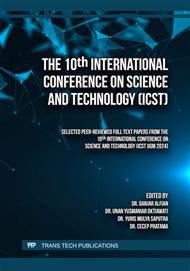[1]
FAO. Biosecurity Principles and Components. Part. 1. In FAO Biosecurity Toolkit; Food and Agriculture Organization of the United Nations: Rome, Italy, 2007, p.1–20. Available online: https://www.fao.org/3/a1140e/a1140e.pdf (accessed on October 20th 2024).
DOI: 10.2172/1329289
Google Scholar
[2]
Renault, V., Humblet, M. F., & Saegerman, C. Biosecurity concept: Origins, evolution and perspectives. Animals, 12(1), 63. (2021).
DOI: 10.3390/ani12010063
Google Scholar
[3]
Liao, K., Yang, F., Dang, H., Wu, Y., Luo, K., & Li, G. Detection of Eucalyptus Leaf Disease with UAV Multispectral Imagery. Forests, 13(8). (2022).
DOI: 10.3390/f13081322
Google Scholar
[4]
Hansen, M., P. P., Moore, R., Hancher, M., Turubanova, S. A., Tyukavina, A., & Townshend, J. High-resolution global maps of 21st-century Forest Cover Change. Science, 850-853. (2013).
DOI: 10.1126/science.1244693
Google Scholar
[5]
Lei, S., Luo, J., Tao, X., & Qiu, Z. (2021). Remote Sensing Detecting of Yellow Leaf Disease of Arecanut Based on UAV Multisource Sensors. Remote Sensing, 13(22).
DOI: 10.3390/rs13224562
Google Scholar
[6]
Stone, C., & Mohammed, C. (2017). Application of Remote Sensing Technologies for Assessing Planted Forests Damaged by Insect Pests and Fungal Pathogens: a Review. Current Forestry Reports, 3(2), 75–92.
DOI: 10.1007/s40725-017-0056-1
Google Scholar
[7]
Matese, A., Di Gennaro, S. F., & Berton, A. Assessment of a Canopy Height Model (CHM) in a vineyard using UAV-based multispectral imaging. International Journal of Remote Sensing, 38(8-10), 2150-2160. (2017).
DOI: 10.1080/01431161.2016.1226002
Google Scholar
[8]
Ramalho de Oliveira, L. F., Lassiter, H. A., Wilkinson, B., Whitley, T., Ifju, P., Logan, S. R., & Martin, T. A. Moving to automated tree inventory: Comparison of uas-derived lidar and photogrammetric data with manual ground estimates. Remote Sensing, 13(1), 72. (2020).
DOI: 10.3390/rs13010072
Google Scholar
[9]
Hematang, F., Murdjoko, A., & Hendri, H. Model Pendugaan Diameter Pohon Berbasis Citra Unmanned Aerial Vehicle (UAV) Pada Hutan Hujan Tropis Papua: Studi Di Pulau Mansinam Papua Barat (Model of Tree Diameter Estimation Based on Unmanned Aerial Vehicle (UAV) Image in Papua Tropical Rain Forest: a Study in Mansinam Island Papua Barat). Jurnal Penelitian Kehutanan Faloak, 5(1), 16–30. (2021).
DOI: 10.20886/jpkf.2021.5.1.16-30
Google Scholar
[10]
Dell, M., Stone, C., Osborn, J., Glen, M., McCoull, C., Rimbawanto, A., Tjahyono, B., & Mohammed, C. Detection of necrotic foliage in a young Eucalyptus pellita plantation using unmanned aerial vehicle RGB photography–a demonstration of concept. Australian Forestry, 82(2), 79–88. (2019).
DOI: 10.1080/00049158.2019.1621588
Google Scholar
[11]
Tuominen, J., Lipping, T., Kuosmanen, V., & Haapanen, R. Remote Sensing of Forest Health. Geoscience and remote sensing, 29-52. (2009).
DOI: 10.5772/8283
Google Scholar
[12]
Aji, Dito Seno, & LM Sabri LM Sabri. Analisis Akurasi Dem Dan Foto Tegak Hasil Pemotretan Dengan Pesawat Nir Awak DJI Phantom 4 (Studi Kasus: Bukit Perumahan Permata Hijau Tembalang Semarang). Jurnal Geodesi Undip, 8(2), 8-18. (2019).
DOI: 10.24014/jej.v5i2.37822
Google Scholar
[13]
Dandois, Jonathan P., Marc Olano, & Erle C. Ellis. Optimal altitude, overlap, and weather conditions for computer vision UAV estimates of forest structure. Remote sensing, 7(10). (2015)
DOI: 10.3390/rs71013895
Google Scholar
[14]
Yang, Yuan, Yongjiang Huang, Haoran Yang, Tingting Zhang, Zixuan Wang, and Xixiang Liu. "Real-time terrain-following of an autonomous quadrotor by multi-sensor fusion and control."Applied Sciences 11(3). (2021).
DOI: 10.3390/app11031065
Google Scholar
[15]
Dash, J. P., Watt, M. S., Pearse, G. D., Heaphy, M., & Dungey, H. S. Assessing very high resolution UAV imagery for monitoring forest health during a simulated disease outbreak. ISPRS Journal of Photogrammetry and Remote Sensing, 131, 1–14. (2017).
DOI: 10.1016/j.isprsjprs.2017.07.007
Google Scholar


